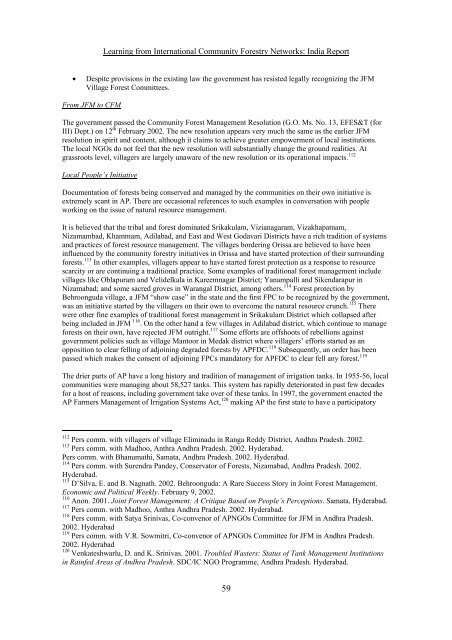Snapshots of International Community Forestry Networks: Country ...
Snapshots of International Community Forestry Networks: Country ...
Snapshots of International Community Forestry Networks: Country ...
Create successful ePaper yourself
Turn your PDF publications into a flip-book with our unique Google optimized e-Paper software.
Learning from <strong>International</strong> <strong>Community</strong> <strong>Forestry</strong> <strong>Networks</strong>: India Report<br />
• Despite provisions in the existing law the government has resisted legally recognizing the JFM<br />
Village Forest Committees.<br />
From JFM to CFM<br />
The government passed the <strong>Community</strong> Forest Management Resolution (G.O. Ms. No. 13, EFES&T (for<br />
III) Dept.) on 12 th February 2002. The new resolution appears very much the same as the earlier JFM<br />
resolution in spirit and content, although it claims to achieve greater empowerment <strong>of</strong> local institutions.<br />
The local NGOs do not feel that the new resolution will substantially change the ground realities. At<br />
grassroots level, villagers are largely unaware <strong>of</strong> the new resolution or its operational impacts. 112<br />
Local People’s Initiative<br />
Documentation <strong>of</strong> forests being conserved and managed by the communities on their own initiative is<br />
extremely scant in AP. There are occasional references to such examples in conversation with people<br />
working on the issue <strong>of</strong> natural resource management.<br />
It is believed that the tribal and forest dominated Srikakulam, Vizianagaram, Vizakhapatnam,<br />
Nizamambad, Khammam, Adilabad, and East and West Godavari Districts have a rich tradition <strong>of</strong> systems<br />
and practices <strong>of</strong> forest resource management. The villages bordering Orissa are believed to have been<br />
influenced by the community forestry initiatives in Orissa and have started protection <strong>of</strong> their surrounding<br />
forests. 113 In other examples, villagers appear to have started forest protection as a response to resource<br />
scarcity or are continuing a traditional practice. Some examples <strong>of</strong> traditional forest management include<br />
villages like Oblapuram and Velidelkala in Kareemnagar District; Yanampalli and Sikendarapur in<br />
Nizamabad; and some sacred groves in Warangal District, among others. 114 Forest protection by<br />
Behroonguda village, a JFM “show case” in the state and the first FPC to be recognized by the government,<br />
was an initiative started by the villagers on their own to overcome the natural resource crunch. 115 There<br />
were other fine examples <strong>of</strong> traditional forest management in Srikakulam District which collapsed after<br />
being included in JFM 116 . On the other hand a few villages in Adilabad district, which continue to manage<br />
forests on their own, have rejected JFM outright. 117 Some efforts are <strong>of</strong>fshoots <strong>of</strong> rebellions against<br />
government policies such as village Mantoor in Medak district where villagers’ efforts started as an<br />
opposition to clear felling <strong>of</strong> adjoining degraded forests by APFDC. 118 Subsequently, an order has been<br />
passed which makes the consent <strong>of</strong> adjoining FPCs mandatory for APFDC to clear fell any forest. 119<br />
The drier parts <strong>of</strong> AP have a long history and tradition <strong>of</strong> management <strong>of</strong> irrigation tanks. In 1955-56, local<br />
communities were managing about 58,527 tanks. This system has rapidly deteriorated in past few decades<br />
for a host <strong>of</strong> reasons, including government take over <strong>of</strong> these tanks. In 1997, the government enacted the<br />
AP Farmers Management <strong>of</strong> Irrigation Systems Act, 120 making AP the first state to have a participatory<br />
112 Pers comm. with villagers <strong>of</strong> village Eliminadu in Ranga Reddy District, Andhra Pradesh. 2002.<br />
113 Pers comm. with Madhoo, Anthra Andhra Pradesh. 2002. Hyderabad.<br />
Pers comm. with Bhanumathi, Samata, Andhra Pradesh. 2002. Hyderabad.<br />
114 Pers comm. with Surendra Pandey, Conservator <strong>of</strong> Forests, Nizamabad, Andhra Pradesh. 2002.<br />
Hyderabad.<br />
115 D’Silva, E. and B. Nagnath. 2002. Behroonguda: A Rare Success Story in Joint Forest Management.<br />
Economic and Political Weekly. February 9, 2002.<br />
116 Anon. 2001. Joint Forest Management: A Critique Based on People’s Perceptions. Samata, Hyderabad.<br />
117 Pers comm. with Madhoo, Anthra Andhra Pradesh. 2002. Hyderabad.<br />
118 Pers comm. with Satya Srinivas, Co-convenor <strong>of</strong> APNGOs Committee for JFM in Andhra Pradesh.<br />
2002. Hyderabad<br />
119 Pers comm. with V.R. Sowmitri, Co-convenor <strong>of</strong> APNGOs Committee for JFM in Andhra Pradesh.<br />
2002. Hyderabad<br />
120 Venkateshwarlu, D. and K. Srinivas. 2001. Troubled Wasters: Status <strong>of</strong> Tank Management Institutions<br />
in Rainfed Areas <strong>of</strong> Andhra Pradesh. SDC/IC NGO Programme, Andhra Pradesh. Hyderabad.<br />
59

















![CynefinFramework final [Read-Only]](https://img.yumpu.com/19017304/1/190x135/cynefinframework-final-read-only.jpg?quality=85)